July 27, 2016

In the world of "somebody's got to do it" the life of a biologist and plant breeder can be a lot of fun, but perhaps the target crop has some bad days. That's what Farm Industry News got a look at recently on a tour of soybean breeding facilities for DuPont Pioneer. And one striking part of that tour of the company's Moorhead, Minn., Lawrence, Kan., Dallas Center, Iowa, and Napoleon, Ohio, facilities was the tough testing they put soybeans through.
There are a lot of diseases out there that rob your soybean crop of yield potential, but companies breed to overcome those problems, and they test for disease impact.
Ever wonder where those crop disease ratings for specific seeds come from on those Pioneer variety information sheets? They come from what we would call disease torture plots across several company facilities. Each plot designed to make sure the disease exists in the area, and that plants are pushed to determine actual impact in field trials. The company replicates the "torture tests" across a number of sites and researchers in each location rate the plants based on the severity of damage they see.
The final number you see on those information brochures is a final average number from a number of test locations, just to take out any variability in ratings. And for those test soybeans, let's just say it's a soybean's not so good very bad day.
Creating a white mold incubator
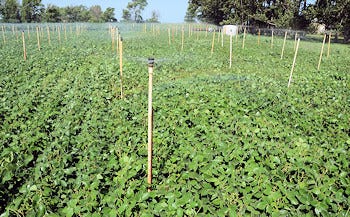
Sprinklers help keep this tightly-planted soybean plot wet enough to grow white mold so the company can conduct disease review of new varieties.
White mold is the bane of high-yield soybeans, and while there are seed treatments that can help prevent the problem and other ways to treat, genetics will probably be the best source of protection for most plants. DuPont Pioneer tests all their soybean varieties for their resistance to white mold, and it's a rating that can keep a promising, high-yielder from making the team.
But how do you set up a white mold plot? How about a small field of sprinklers and plantings of all the major varieties you want to test in a season? At the Moorhead facility, the sprinklers are on a 10-minute cycle (yes we got damp during our visit) keeping the plants wet, but not too wet, so the mold spores have a chance to grow.
The crop is infected by spreading sorghum seeds treated with the mold that lands on leaves and infects plants. Actually kind of simple, and the long-term hope is that the test field will gain enough of a population of the white mold that it won't need to be 'treated' each season to put soybean varieties to the test.
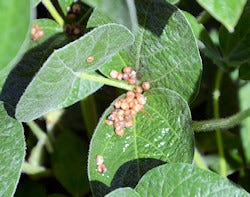
To infect a soybean plant with white mold, sorghum seed that's been treated with the spores is broadcast over the field.
Moorhead is a key white mold test area, but other facilities - like Napoleon, Ohio - also have white mold test beds. The point is to test varieties in their main region - so in Moorhead it's Group 0 and 00 varieties, while in Ohio it would be mid Group 2 and to mid Group 3 varieties. The point is learn from the plant in the optimum environment for disease development.
And there's Iron Chlorosis
Iron-deficient chlorosis is a bane of bean producers in the Midwest. The disease expresses differently across the country, for example in the north the disease is based on soil pH. The Moorhead area has soil pH ranges up to 8, which becomes a challenge for that soybean plant looking to take up iron at critical growth stages.
Genetics will be the best defense against this disease, notes Nadia Krasheninnik, a research scientist at the Moorhead facility, who also designed the white mold test area. Like the white mold area, the iron chlorosis area is a place where dozens of varieties are planted and rated in early stages of development.
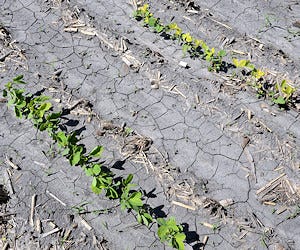
Iron chlorosis is big trouble in some parts of the country, and Pioneer tests varieties for susceptibility. It is sometimes not about whether they get the problem, but if they can grow through it with little yield impact. The plot on the right is at least susceptible - too early to know if it will grow through it.
Plants that don't score well when challenged by the disease don't get to move on in the development trial, and as Pioneer makes more use of AYT 4.0 technology to characterize genetics for selecting next-generation varieties, they'll also be able to identify the plants with the best genetic makeup to tackle the disease.
The images shown here give you an idea of the nature of the iron chlorosis test. More than 500 soybean varieties are being tested in this Moorhead location alone.
Sudden death "valley"
On the trip, the group entered a field near Lawrence, Kan., that looked lush and green, but of course it's part of the extensive testing for seed development underway. Essentially the field was a ticking time bomb of sudden death syndrome.

This field is a ticking time bomb of sudden death syndrome - a disease that can't be beaten through rotation since the disease likes to
The field location - linked to the Pioneer Lawrence, Kan., research facility - is a plot of ground chock full of fusarium biding its time until soybeans hit the right maturity level. It's a piece of ground Pioneer rented from a cooperator who said he had a long-time problem in that field. Today it's test plot to check the resilience of soybean varieties to the disease.
Les Kuhlman, research biologist, Lawrence, Kan., shares that they have similar trials in six other areas where ratings for SDS impact are taking and varieties are ranked. This is how you get those SDS ratings you see in seed guides, some plants have to suffer to pull the information.
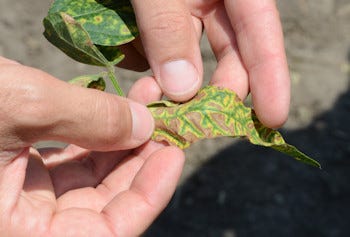
Classic SDS shows with the leaf veins retaining their color. That's a sign, for at least a bad sign.
Kuhlman showed some classic symptoms of SDS in a field with an earlier maturing soybean; including the green veins of an infected leaf. Dramatic for sure.
As with the white mold and iron chlorosis plots, ratings are taking for every variety in the field. Plots are in 5-foot by 5-foot sections and hundreds of varieties are tested at the same time.
Taking on a root disease
Phytophthora is a tough disease on soybeans, but breeders across the industry have made great headway developing varieties that are resistant to to the disease. At the Napolean, Ohio, Pioneer research facility - home to a lot of work on the company's Plenish high-oleic product development too - Rhiannon Schneider is hard at work evaluating lines for resistance to the problem.
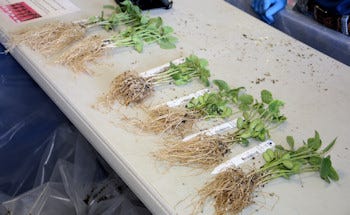
This display shows how researchers measure roots and their impact from phytophthora. Root ratings offer insight into plant resistance.
Schneider, who's graduate thesis focused on phytophthora is a research associate at the Napoleon facility. This is a center for evaluation of phytophthora resistance for Pioneer. Schneider grows out plants in Styrofoam cups where with the disease in dishes inside along with vermiculite as a growth medium.
She can then easily remove plants to evaluate the impact level of the root disease on candidate varieties rating them in the Pioneer system from 0 (bad) to 9 (untouched). How candidate varieties perform here is also one factor that could keep one out of the line. And if it's a high-producer with some susceptibility, the ratings give farmers the information they need.
Bring on the flood
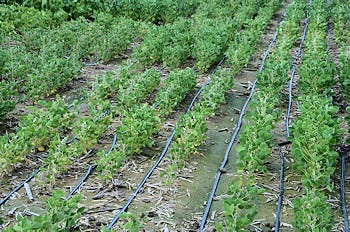
The flood test is just that, a look at how different varieties respond to
Reid Rice, research scientist, Napoleon, Ohio, is responsible for a lot of the work on Plenish varieties, putting those same varieties through the tests more conventional beans face. And there's one he does, that he notes he doesn't have to do - a flood test.
Varieties are planted in a field and then flooded out to determine which like "wet feet" and which don't. It's a fascinating trial because there's a true flood response for some varieties, that can be included in ratings for farmers. Flood testing is done at other locations too, and those ratings are based on plots that are put under water.
For the farmer with that field that seems to get wet on the low end every year, those flood ratings have value.
Beyond disease, bugs
You can focus on disease - and in soybeans it's not like there aren't a few, as noted above, but what about those bugs. Soybean aphids, green stinkbugs, brown marmorated stinkbugs, kudzu bugs - frankly soybeans can just be buggy.
At the Pioneer Dallas Center facility west of Des Moines, there's an insectory where bug-happy researchers get to test varieties for native and genetic resistance to these pests. It was through sampling aphids that Pioneer discovered a fourth biotype, which broke through the resistance under development at the company.
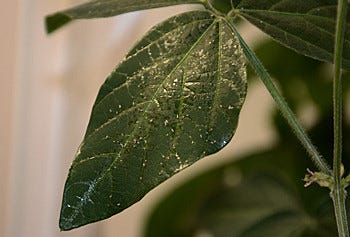
Here's a telltale sign of aphids you'd rather not see - the shiny look. Pioneer is close to market with soybean varieties that are resistant to all known types of soybean aphid in the U.S.
However, there are varieties near market that are now resistant to all known biotypes of aphid, and Pioneer researchers - like Molly Ryan, a senior researcher who works to identify native resistance in plants - are excited by what they're seeing. A look at plants in test showed that even with biotype 4, the new genetics - not biotech - were performing well.
Interestingly, they can identify genetics that are resistant to aphids, but they're still working on learning how it works in the plant. That's not a requirement to introduce native soybean plants to the market, but longer term understanding that resistance mechanism will be important to future product development.
There's a reason the military has bootcamp, it takes raw recruits and hones them into fighting machines. For soybeans, the raw recruits are new varieties that come to "training" with known genetics, and included traits, yet more has to be learned. Every variety that enters trials has a chance to perform, but when the selection process starts with as many as 40,000 candidates that must be narrowed to the very few it's no surprise that tough testing is part of the mix.
About the Author(s)
You May Also Like






